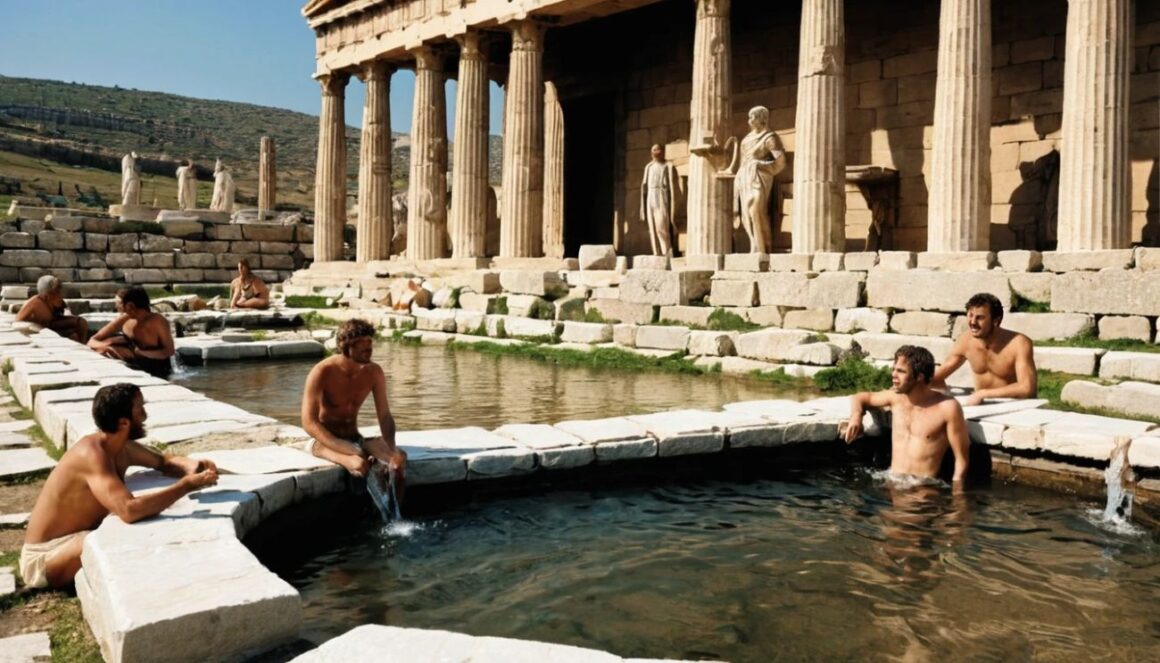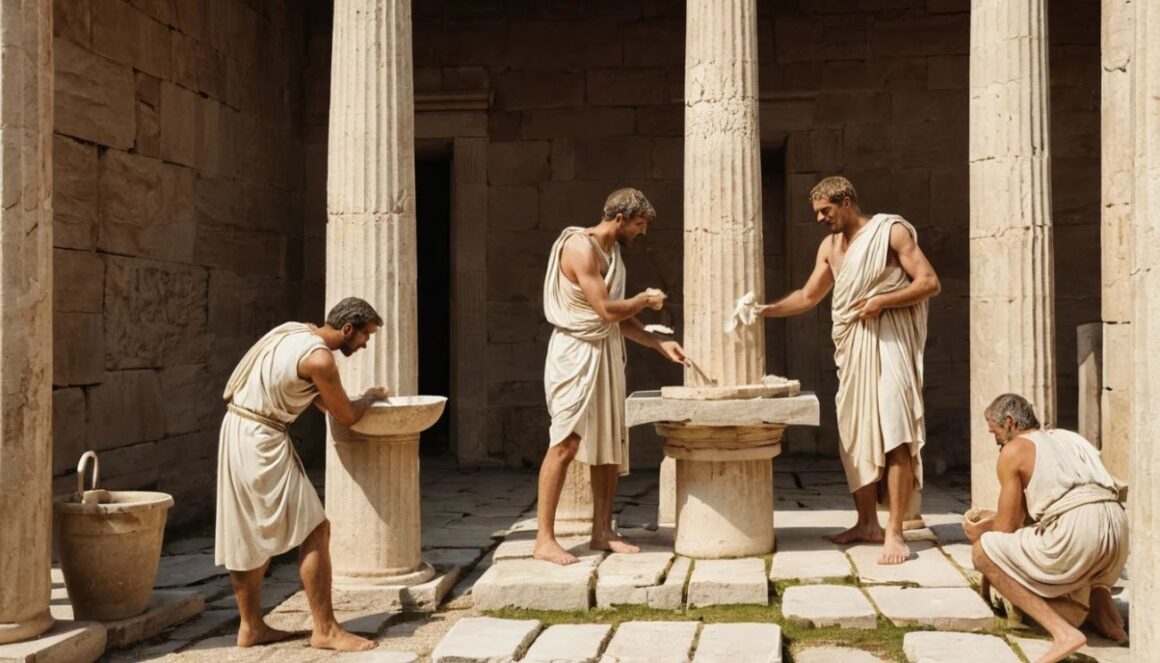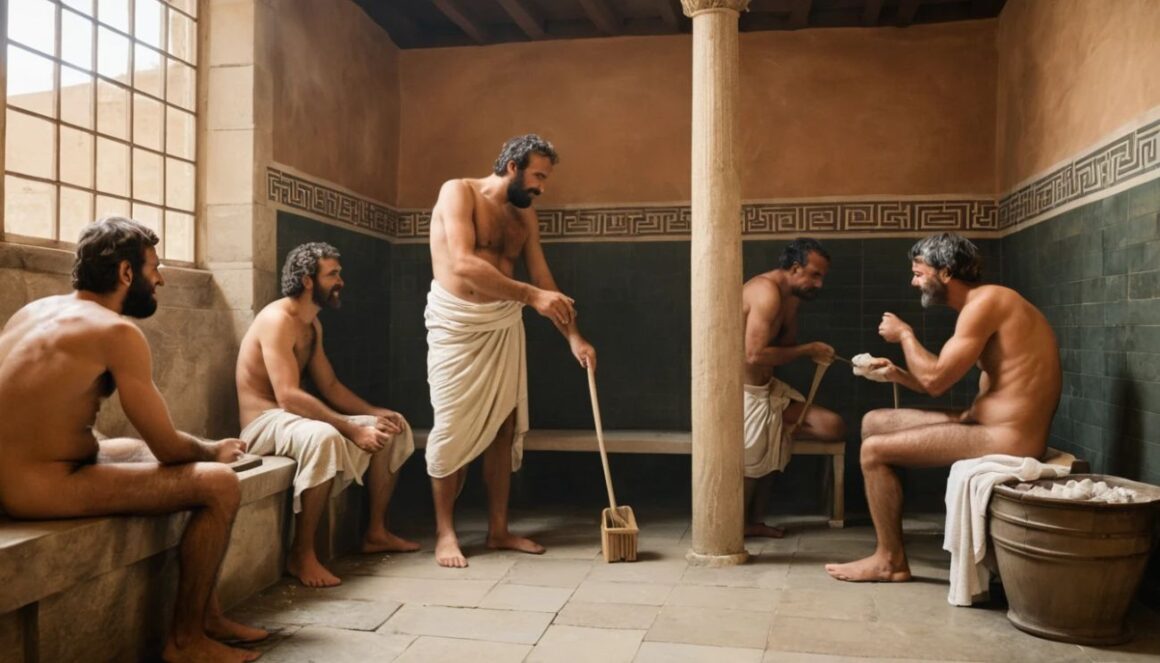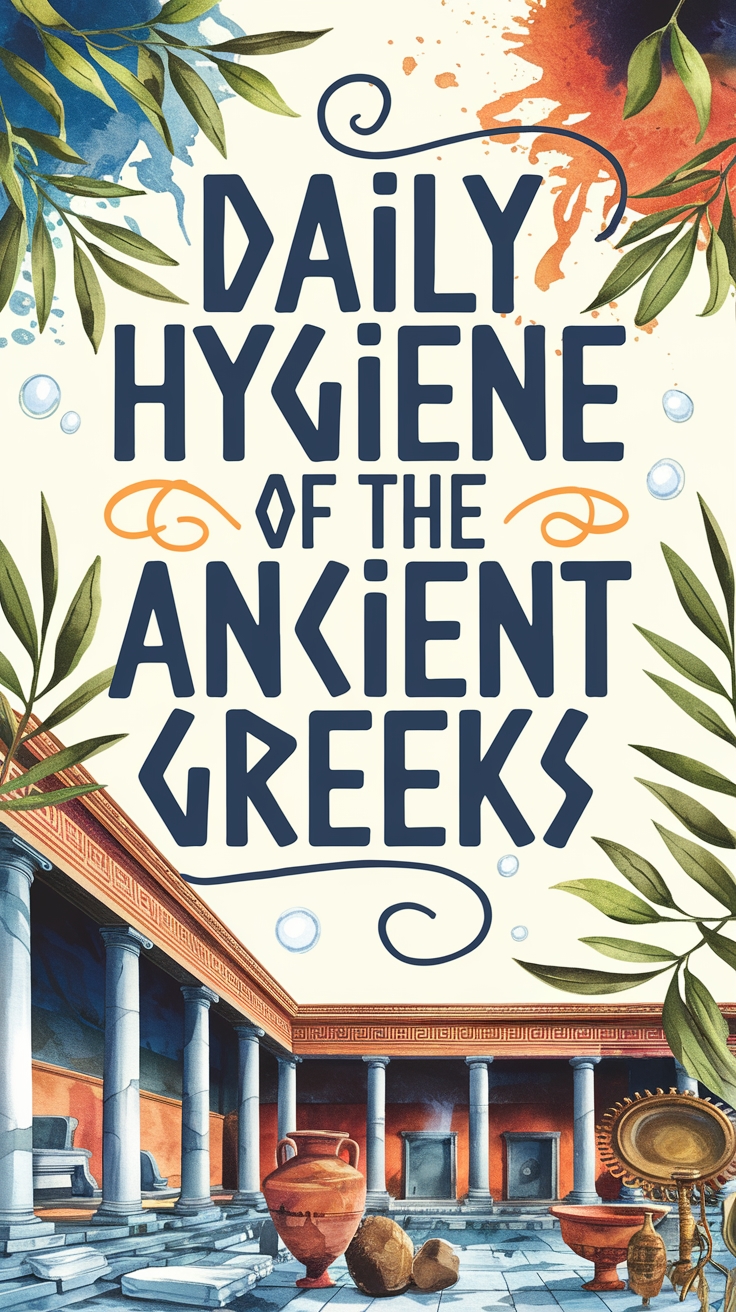The Ancient Greeks, celebrated for their philosophical insights, architectural marvels, and athletic pursuits, also cultivated a culture of cleanliness that reflected their values of harmony, health, and beauty. Hygiene was not merely about physical cleanliness but also about achieving a balance between the body and mind. Their practices, guided by practicality, aesthetics, and spiritual beliefs, reveal a society deeply invested in personal and public cleanliness.
This article explores the daily hygiene practices of men and women in Ancient Greece, including bathing, grooming, oral care, menstrual hygiene, and sanitation, with references to documented practices and archaeological discoveries.
Bathing: Rituals of Purification and Relaxation

For the Ancient Greeks, bathing was a fundamental part of daily life, serving purposes that extended beyond hygiene. It was a social, medical, and even spiritual activity.
Bathing Practices
Bathing facilities varied from simple basins in private homes to elaborate public baths. Wealthier Greeks often bathed at home using terracotta or metal basins, pouring water over themselves with jars called hydriae. The water was usually drawn from wells or natural springs. Public baths, which became more common during the Hellenistic period, were social hubs where citizens gathered to relax, converse, and cleanse their bodies.
The Greeks often bathed in cold water, believing it invigorated the body and prevented disease. However, warm baths were also used, particularly for therapeutic purposes. Temples dedicated to Asclepius, the god of healing, frequently included facilities for warm-water bathing, which was considered part of the healing process.
Soap Substitutes
Instead of soap, the Greeks used olive oil mixed with fine sand or ash to cleanse their skin. After applying the mixture, they would scrape it off with a tool called a strigil, removing dirt and sweat. This method left the skin clean and moisturized.
Spiritual and Ritual Significance
Bathing was closely tied to religious and cultural practices. For instance, athletes bathed before and after competitions to purify themselves, and women bathed before marriage ceremonies. The Greek concept of katharsis, meaning purification, extended to both physical and spiritual cleanliness.
Oral Hygiene: Early Efforts for Clean Teeth
Oral hygiene in Ancient Greece was rudimentary but surprisingly effective for its time.
Tooth-Cleaning Practices
Greeks cleaned their teeth using chew sticks made from aromatic twigs, such as mastic or willow. These sticks, chewed at one end until frayed, acted like primitive toothbrushes. Charcoal, crushed bones, and powdered oyster shells were used as abrasives to clean teeth and whiten them.
Diet and Dental Health
The Greek diet, rich in grains, fruits, vegetables, and honey, contributed to dental health but also caused wear on their teeth due to the coarse texture of bread made with stone-ground flour. Despite their efforts, tooth decay and gum disease were common, especially among wealthier individuals who consumed more sugary treats.
Medicinal Remedies
Hippocratic texts recommend rinsing the mouth with wine and applying crushed herbs like mint or myrrh to alleviate toothaches. These practices highlight the Greeks’ understanding of antiseptic properties in natural substances.
Grooming: Beauty as a Reflection of Virtue

Grooming in Ancient Greece was an art form that reflected societal values of beauty, balance, and self-discipline.
Haircare
Hair was a significant marker of identity and social status. Men typically kept their hair short and well-groomed, especially during wartime, while women wore their hair long, often styled in elaborate braids or buns. Unmarried women usually let their hair flow freely, while married women covered it with veils or scarves.
Oils derived from olives, almonds, or sesame were applied to hair to keep it shiny and healthy. Combs made from bone, ivory, or wood were commonly used for detangling and styling, as evidenced by artifacts found in sites like Athens and Corinth.
Beards and Shaving
Beards were a symbol of masculinity and wisdom among Greek men, particularly philosophers like Socrates and Plato. However, shaving became fashionable during the reign of Alexander the Great, who encouraged soldiers to shave their beards to prevent enemies from grabbing them in battle. Bronze razors and pumice stones were common tools for maintaining a clean-shaven look.
Skincare and Cosmetics
Both men and women used oils and creams to protect their skin from the harsh Mediterranean sun. Women also used makeup, including red ochre for rouge, charcoal for eyeliner, and white lead to lighten their complexion. Though the use of lead-based cosmetics was harmful, it was a common beauty practice among the upper classes.
Nail Care
Well-maintained nails were an essential aspect of grooming. Greeks used knives and files to trim and shape their nails, and wealthier individuals employed servants to assist with these tasks.
Menstrual Hygiene: Discretion and Practicality

Menstrual hygiene in Ancient Greece was managed with resourceful and effective methods.
Absorbent Materials
Women used cloth pads made from wool or linen, which were washable and reusable. Wealthier women likely had access to finer materials, while poorer women used simpler, coarser fabrics.
Cultural and Medical Perspectives
Menstruation was viewed through the lens of humoral theory, as described by Hippocrates. It was believed that menstruation helped balance bodily fluids and expel impurities. However, it was also considered a source of ritual impurity, leading to certain restrictions, such as abstaining from religious ceremonies during menstruation.
Medicinal Support
Greek physicians recommended herbal remedies like fennel and anise to regulate menstrual cycles and ease cramps. These herbs were prepared as teas or poultices.
Sanitation and Toilets: Ingenious and Practical

The Ancient Greeks developed practical systems for sanitation, reflecting their ingenuity and civic planning skills.
Toilets
Private homes in affluent areas often featured rudimentary toilets consisting of clay pots or stone seats placed over cesspits. These pits were regularly emptied to prevent foul odors. Public latrines, commonly found in cities like Athens, were communal facilities with stone benches and flowing water channels to carry away waste.
Waste Disposal
In urban areas, waste was collected and removed by designated workers, reflecting the Greeks’ efforts to maintain public hygiene. However, rural areas relied on simpler methods, such as burying waste.
Handwashing
Handwashing was a common practice, particularly before meals and religious rituals. Basins and jugs, often made from terracotta or bronze, were used for this purpose.
Perfumes and Deodorants: Scent as a Social Statement
The Greeks were passionate about perfumes, using them to mask body odors, signify wealth, and enhance their attractiveness.
Perfume Production
Perfumes were crafted using oils infused with herbs, flowers, and spices. Popular ingredients included rose, lavender, cinnamon, and myrrh. These perfumes were stored in intricately designed alabaster or ceramic jars, many of which have been discovered in Greek tombs.
Deodorants
To combat body odor, Greeks used powdered natron mixed with fragrant oils or herbs. These were applied to the body after bathing, leaving the skin both clean and pleasantly scented.
Trivia and Curiosities
- Athletes’ Hygiene: Greek athletes oiled their bodies before competitions to protect their skin and then scraped off the oil and sweat with a strigil after events. This ritual was both hygienic and symbolic of their dedication to physical excellence.
- Symbolic Hair Offerings: Hair was often cut and offered to the gods during significant life events, such as coming of age or mourning.
- Early Plumbing: The Minoans, precursors to the Greeks, developed advanced plumbing systems, including flushable toilets and piped water, as seen in the Palace of Knossos on Crete.
Conclusion
The Ancient Greeks’ approach to hygiene was a reflection of their broader cultural values: balance, beauty, and respect for the body. From their meticulous bathing rituals to their innovative sanitation systems, they demonstrated a sophisticated understanding of cleanliness and its role in daily life.
By blending practicality with aesthetic ideals, the Greeks set standards for hygiene that influenced future civilizations, leaving a legacy of care and refinement that continues to inspire admiration today.





